A New Integrated Model for Simulating Adaptive Cycle Engine Performance Considering Variations in Tip Clearance
Abstract
:1. Introduction
2. Case Description
3. Methodology
3.1. ACE Performance Simulation Method
3.1.1. Zero-Dimensional Engine Performance Simulation Model
3.1.2. Three-Dimensional Adaptive Fan Numerical Simulation Model
3.1.3. One-Dimensional LPT Mean Line Model
3.2. MD Tip Clearance Prediction Model
3.2.1. Shroud Modeling
3.2.2. Blade Modeling
3.2.3. Disk Modeling
3.3. Model Validation
3.3.1. Validation of the ACE Performance Simulation Method
3.3.2. Validation of the Tip Clearance Model
3.4. The Integration of the Models
- The ACE’s performance in double-bypass mode is calculated through the 0D performance model. Furthermore, it provides boundary conditions for the 3D simulation model of the front and rear fans, the 1D mean line model of the LPT, and the MD tip clearance model of the fans and the LPT.
- The MD tip clearance model provides the predicted tip clearances for the front and rear fans and the LPT under different rotating speeds. Moreover, the boundary conditions for the tip clearance model originate from the 0D performance model, including the temperature and mass flow rate of the airflow through the components and the rotating speed.
- The 3D simulation model calculates the impact of clearance variations on the characteristic maps of the front and rear fans, using the tip clearances from the clearance model and the boundary conditions from the 0D performance model. The new maps are then used to replace the front and rear fan maps in the 0D performance model.
- The 1D mean line model is used to calculate the impact of variations in tip clearance on the performance of the LPT, using the tip clearances from the clearance model and the boundary conditions from the 0D engine model. The map is then updated and processed for the LPT, meaning that several iterations between the 0D performance model and the 1D mean line model are processed to calculate the LPT’s performance.
- Finally, the engine performance considering the effect of variations in the tip clearance can be obtained.
4. Results Analysis
4.1. Tip Clearance Model Prediction Results
4.2. Characteristic Maps of the Adaptive Fan
4.3. Characteristic Maps of the LPT
4.4. Engine Performance Evaluation
5. Conclusions
- This paper developed a new integrated model for predicting the performance of an ACE, including a 0D engine performance simulation model, a 3D adaptive fan numerical simulation model, a 1D LPT mean line model, and an MD tip clearance prediction model. Specifically, the 0D model provides the boundary conditions for the 1D LPT, 3D adaptive fan, and MD tip clearance models. Then, the MD tip clearance model provides the predicted clearances for the 3D adaptive fan and 1D LPT models, so the impact of the variation in tip clearance on the components can be considered. Finally, after replacing the map of the adaptive fan and updating the map of the LPT, the ACE performance can be obtained while considering the effect of the variant clearance.
- The traditional 0D engine performance model mainly adopts empirical relations and variable multi-angle characteristic maps for predicting the maps of the components, which usually cannot meet the design and analysis requirements of engineers and researchers for the ACE. The new integrated model combines high-fidelity models of the adaptive fan and LPT, and the accuracy of the adaptive fan and LPT model was validated via experiments. Moreover, the MD tip clearance model, validated via the 3D FSTM, further improves the accuracy of the prediction of the ACE’s performance, as it considers the variation in the tip clearance under different operating conditions.
- The integrated model calculated the performance of the ACE considering variations in the tip clearance under different operating conditions, and the results were compared with the performance of an ACE with the assembled clearance values. When compared with the performance of the ACE without considering the clearance variations, the thrust under the design conditions increased by 1%, and the SFC decreased by 0.3%. Moreover, this indicates that the impact of tip clearance on the performance of an ACE cannot be ignored.
Author Contributions
Funding
Data Availability Statement
Conflicts of Interest
Nomenclature
| a | Blade Area Coefficient or Thermal Diffusion Coefficient |
| B | Constant Defined by The Kacker–Okapuu Loss System |
| E | Modulus of Elasticity |
| H | Blade Height |
| i | Incidence Angle |
| istall | Stalling Incidence Angle |
| Lblade | Blade Length |
| N | Rotating Speed |
| r | Radius |
| rdisk | Radius of The Disk Rim |
| t | Time or Blade Thickness |
| tcl | Tip Clearance |
| tmax | Maximum Blade Thickness |
| T | Temperature |
| T4 | Turbine Inlet Temperature |
| Tcool | Temperature of The Cooling Flow |
| Tf | Temperature of The Fluid |
| TC | Tip Clearance |
| TCassemble | Assembled Tip Clearance |
| u | Deformation of The Component |
| x | Radial Distance from The Chosen Section to The Blade Hub |
| Z | Ainley-Mathieson Loading Parameter |
| Thermal Expansion Coefficient | |
| β | Flow Angle |
| βm | Metal Angle |
| γ | Stagger Angle |
| Clearance Loss Coefficient | |
| δ | Deviation Angle |
| Radial Unit Length of The Node | |
| Time Change in Every Time Step | |
| Axial Unit Length of The Node | |
| Film Cooling Efficiency | |
| Radial Distance from The Element to The Blade Hub | |
| Density | |
| Time Constant | |
| ω | Profile Loss Coefficient |
| ωref | Profile Loss Coefficient of The Reference Value |
| Acronyms | |
| 0D | Zero-dimensional |
| 1D | One-dimensional |
| 1DM | One-Dimensional Tip Clearance Model |
| 2D | Two-Dimensional |
| 3D | Three-Dimensional |
| ACE | Adaptive Cycle Engine |
| CDFS | Core-Driven Fan Stage |
| CFD | Computational Fluid Dynamics |
| CHT | Conjugate Heat Transfer |
| Fo | Fourier Number |
| FSTM | Fluid–Solid Thermal Coupling Method |
| FVABI | Front Variable Area Bypass Injector |
| HPC | High-Pressure Compressor |
| HPT | High-Pressure Turbine |
| IGV | Inlet Guide Vane |
| LPT | Low-Pressure-Turbine |
| MD | Multi-dimensional |
| MDM | Multi-dimensional Tip Clearance Model |
| MOBY | Modulating Bypass |
| Re | Reynolds Number |
| RPM | Revolutions Per Minute |
| SFC | Specific Fuel Consumption |
| SST | Shear Stress Transport |
| T-MATS | Toolbox for the Modeling and Analysis of Thermodynamic Systems |
| VABI | Variable Area Bypass Injector |
| Superscripts and Subscripts | |
| 1 | Blade Inlet |
| 2 | Blade Outlet |
| blade | Parameters of The Blade |
| disk | Parameters of The Disk |
| i | Axial Position of The Node |
| j | Radial Position of The Node |
| p | Time Step |
| r | Radial Position |
| shroud | Parameters of The Shroud |
References
- Westmoreland, J.S.; Howlett, R.A.; Lohmann, R.P. Progress on Variable Cycle Engines. In Proceedings of the 15th Joint Propulsion Conference, Las Vegas, NV, USA, 18–20 June 1979. [Google Scholar]
- Claus, R.W.; Evans, A.L.; Lylte, J.K.; Nichols, L.D. Numerical Propulsion System Simulation. Comput. Syst. Eng. 1991, 2, 357–364. [Google Scholar] [CrossRef]
- Alexiou, A.; Baalbergen, E.H.; Kogenhop, O.; Mathioudakis, K.; Arendsen, P. Advanced Capabilities for Gas Turbine Engine Performance Simulations. In Proceedings of the ASME Turbo Expo 2007: Power for Land, Sea, and Air, Montreal, QC, Canada, 14–17 May 2007. [Google Scholar]
- Kim, S.; Kim, D.; Son, C.; Kim, K.; Kim, M.; Min, S. A Full Engine Cycle Analysis of a Turbofan Engine for Optimum Scheduling of Variable Guide Vanes. Aerosp. Sci. Technol. 2015, 47, 21–30. [Google Scholar] [CrossRef]
- Follen, G.; AuBuchon, M. Numerical Zooming between a NPSS Engine System Simulation and a One-Dimensional High Compressor Analysis Code; NASA/TM-2000-209913; NASA: Washington, DC, USA, 2000.
- Kolias, I.; Alexiou, A.; Aretakis, N.; Mathioudakis, K. Axial Compressor Mean-Line Analysis: Choking Modelling and Fully-Coupled Integration in Engine Performance Simulations. Int. J. Turbomach. Propuls. Power 2021, 6, 4. [Google Scholar] [CrossRef]
- Pilet, J.; Lecordix, J.L.; Garcia-Rosa, N.; Barènes, R.; Lavergne, G. Towards a Fully Coupled Component Zooming Approach in Engine Performance Simulation. In Proceedings of the ASME Turbo Expo 2011: Power for Land, Sea, and Air, Vancouver, BC, Canada, 6–10 June 2011. [Google Scholar]
- Klein, C.; Wolters, F.; Reitenbach, S.; Schönweitz, D. Integration of 3D-CFD Component Simulation into Overall Engine Performance Analysis for Engine Condition Monitoring Purposes. In Proceedings of the ASME Turbo Expo 2018: Power for Land, Sea, and Air, Oslo, Norway, 11–15 June 2018. [Google Scholar]
- Zhewen, X.; Ming, L.; Hailong, T.; Chen, M. A Multi-Fidelity Simulation Method Research on Front Variable Area Bypass Injector of an Adaptive Cycle Engine. Chin. J. Aeronaut. 2022, 35, 202–219. [Google Scholar]
- Fu, S.; Li, Z.; Zhanxue, W.; Lin, Z.; Shi, J. Integration of High-Fidelity Model of Forward Variable Area Bypass Injector into Zero-Dimensional Variable Cycle Engine Model. Chin. J. Aeronaut. 2021, 34, 1–15. [Google Scholar]
- Ameri, A.A.; Steinthorsson, E.; Rigby, D.L. Effects of Tip Clearance and Casing Recess on Heat Transfer and Stage Efficiency in Axial Turbines. J. Turbomach. 1999, 121, 683–693. [Google Scholar] [CrossRef]
- Bringhenti, C.; Barbosa, J.R. Effects of Turbine Tip Clearance on Gas Turbine Performance. In Proceedings of the ASME Turbo Expo 2008: Power for Land, Sea, and Air, Berlin, Germany, 9–13 June 2008. [Google Scholar]
- Lattime, S.B.; Steinetz, B.M. High Pressure Turbine Engine Clearance Control Systems: Current Practices and Future Directions. J. Propuls. Power 2004, 20, 302–311. [Google Scholar] [CrossRef]
- Ebert, E.; Reile, E. Bridging The Gap between Structural and Thermal Analysis in Aircraft Engine Design. In Proceedings of the 8th AIAA/USA/NASA/ISSMO Symposium on Multidisciplinary Analysis and Optimization, Long Beach, CA, USA, 6–8 September 2000. [Google Scholar]
- Yu, Y.; Liu, Q.; Shen, B.; Gao, X. Radical Clearance Analysis on the High Pressure Compressor. In Proceedings of the 18th AIAA/3AF International Space Planes and Hypersonic Systems and Technologies Conference, Tours, France, 24–28 September 2012. [Google Scholar]
- Kumar, R.; Kumar, V.S.; Butt, M.M.; Sheikh, N.A.; Khan, S.A.; Afzal, A. Thermo-Mechanical Analysis and Estimation of Turbine Blade Tip Clearance of a Small Gas Turbine Engine under Transient Operating Conditions. Appl. Therm. Eng. 2020, 179, 115700. [Google Scholar] [CrossRef]
- Wei, J.; Yang, H.; Zheng, P.; Wang, B.; Zheng, X. Transient Tip Clearance Prediction Model Considering Transient Radial Temperature Distribution of Discs in a Gas Turbine Engine. In Proceedings of the ASME Turbo Expo 2023, Boston, MA, USA, 26–30 June 2023. in press. [Google Scholar]
- Pilidis, P.; Maccallum, N.R.L. A Study of the Prediction of Tip and Seal Clearances and Their Effects in Gas Turbine Transients. In Proceedings of the ASME 1984 International Gas Turbine Conference and Exhibit, Amsterdam, The Netherlands, 4–7 June 1984. [Google Scholar]
- Kypuros, J.A.; Melcher, K.J. A Reduced Model for Prediction of Thermal and Rotational Effects on Turbine Tip Clearance; NASA/TM–2003–212226; NASA: Washington, DC, USA, 2003.
- Agarwal, H.; Akkaram, S.; Shetye, S.; McCallum, A. Reduced Order Clearance Models for Gas Turbine Applications. In Proceedings of the 49th AIAA/ASME/ASCE/AHS/ASC Structures, Structural Dynamics, and Materials Conference, Schaumburg, IL, USA, 7–10 April 2008. [Google Scholar]
- Chapman, J.W.; Guo, T.H.; Kratz, J.L.; Litt, J.S. Integrated Turbine Tip Clearance and Gas Turbine Engine Simulation. In Proceedings of the 52nd AIAA/SAE/ASEE Joint Propulsion Conference, Salt Lake City, UT, USA, 25–27 July 2016. [Google Scholar]
- Peng, K.; Fan, D.; Yang, F.; Fu, Q.; Li, Y. Active Generalized Predictive Control of Turbine Tip Clearance for Aero-Engines. Chin. J. Aeronaut. 2013, 26, 1147–1155. [Google Scholar] [CrossRef]
- Dong, Y.; Xinqian, Z.; Qiushi, L. An 11-Stage Axial Compressor Performance Simulation Considering the Change of Tip Clearance in Different Operating Conditions. Proc. IMechE Part A J. Power Energy 2014, 228, 614–625. [Google Scholar] [CrossRef]
- Luberti, D.; Tang, H.; Scobie, J.A.; Pountney, O.J.; Owen, J.M.; Lock, G.D. Influence of Temperature Distribution on Radial Growth of Compressor Disks. J. Eng. Gas. Turbines Power 2020, 142, 071004. [Google Scholar] [CrossRef]
- Youlong, F.; Yongbao, L.; Xing, H. Study of the Radial Elongations of the Turbine Rotor with the Centrifugal Effect. Ship Electron. Eng. 2011, 31, 177–180. [Google Scholar]
- Vullo, V.; Vivio, F. Rotors: Stress Analysis and Design; Springer: Berlin, Germany, 2013. [Google Scholar]
- Johnson, J.E. Variable Cycle Engine Developments at General Electric-1955–1995. In Murthy S N B, Curran E T. Developments in High-Speed Vehicle Propulsion Systems; AIAA Inc.: Reston, VA, USA, 1996; pp. 105–158. [Google Scholar]
- Chapman, J.W.; Lavelle, T.M.; May, R.D.; Litt, J.S.; Guo, T.-H. Toolbox for The Modeling and Analysis of Thermodynamic Systems (T-MATS) User’s Guide; NASA/TM-2014-216638; NASA: Washington, DC, USA, 2014.
- Edmunds, D.B. Multivariable Control for a Variable Area Turbine Engine. Master’s Dissertation, Ohio State University, Columbus, OH, USA, 1977. [Google Scholar]
- Grönstedt, T. Development of Methods for Analysis and Optimization of Complex Jet Engine Systems. Ph.D. Dissertation, Chalmers University of Technology, Gothenburg, Sweden, 2000. [Google Scholar]
- Wang, B.; Song, Z.; Zou, W.; Yang, H.; Wen, M.; Zhou, K.; Feng, X.; Zheng, X. Rapid Performance Prediction Model of Axial Turbine with Coupling One-Dimensional Inverse Design and Direct Analysis. Aerosp. Sci. Technol. 2022, 130, 107828. [Google Scholar] [CrossRef]
- Kacker, S.C.; Okapuu, U. A Mean Line Prediction Method for Axial Flow Turbine Efficiency. J. Eng. Power 1982, 104, 111–119. [Google Scholar] [CrossRef]
- Zhu, J.; Sjolander, S.A. Improved Profile Loss and Deviation Correlations for Axial-Turbine Blade Rows. In Proceedings of the ASME Turbo Expo 2005: Power for Land, Sea, and Air, Reno-Tahoe, NV, USA, 6–9 June 2005. [Google Scholar]
- Agromayor, R.; Nord, L.O. Preliminary Design and Optimization of Axial Turbines Accounting for Diffuser Performance. Int. J. Turbomach. Propuls. Power 2019, 4, 32. [Google Scholar] [CrossRef]
- Incropera, F.P.; DeWitt, D.P. Fundamentals of Heat and Mass Transfer; John Wiley & Sons: New York, NY, USA, 1996. [Google Scholar]
- Tachibana, F.; Fukui, S. Convective Heat Transfer of the Rotational and Axial Flow between Two Concentric Cylinders. Bull. JSME 1958, 7, 385–391. [Google Scholar] [CrossRef]
- Kopasakis, G.; Cheng, L.; Connolly, J.W. Stage-by-Stage and Parallel Flow Path Compressor Modeling for a Variable Cycle Engine. In Proceedings of the 51st AIAA/SAE/ASEE Joint Propulsion Conference, Orlando, FL, USA, 27–29 July 2015. [Google Scholar]
- Zheng, X.; Yang, H. Influence of Tip Clearance on the Performance and Matching of Multistage Axial Compressors. In Proceedings of the ASME Turbo Expo 2016: Turbomachinery Technical Conference and Exposition, Seoul, Republic of Korea, 13–17 June 2016. [Google Scholar]
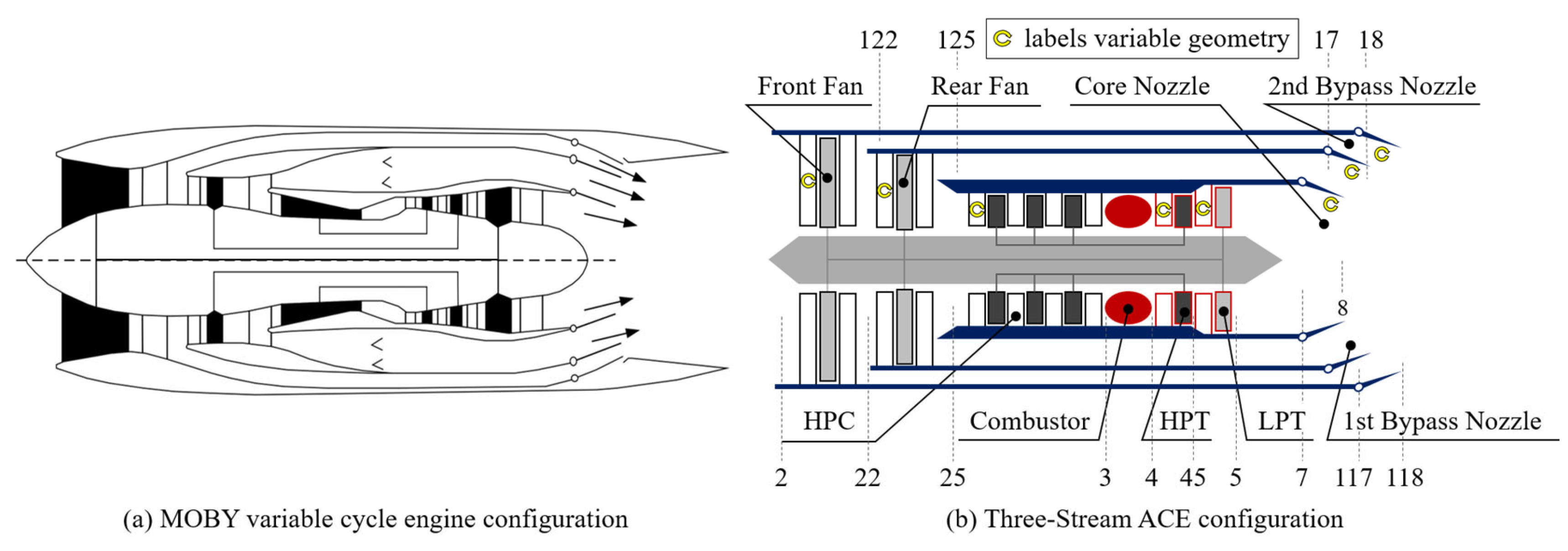

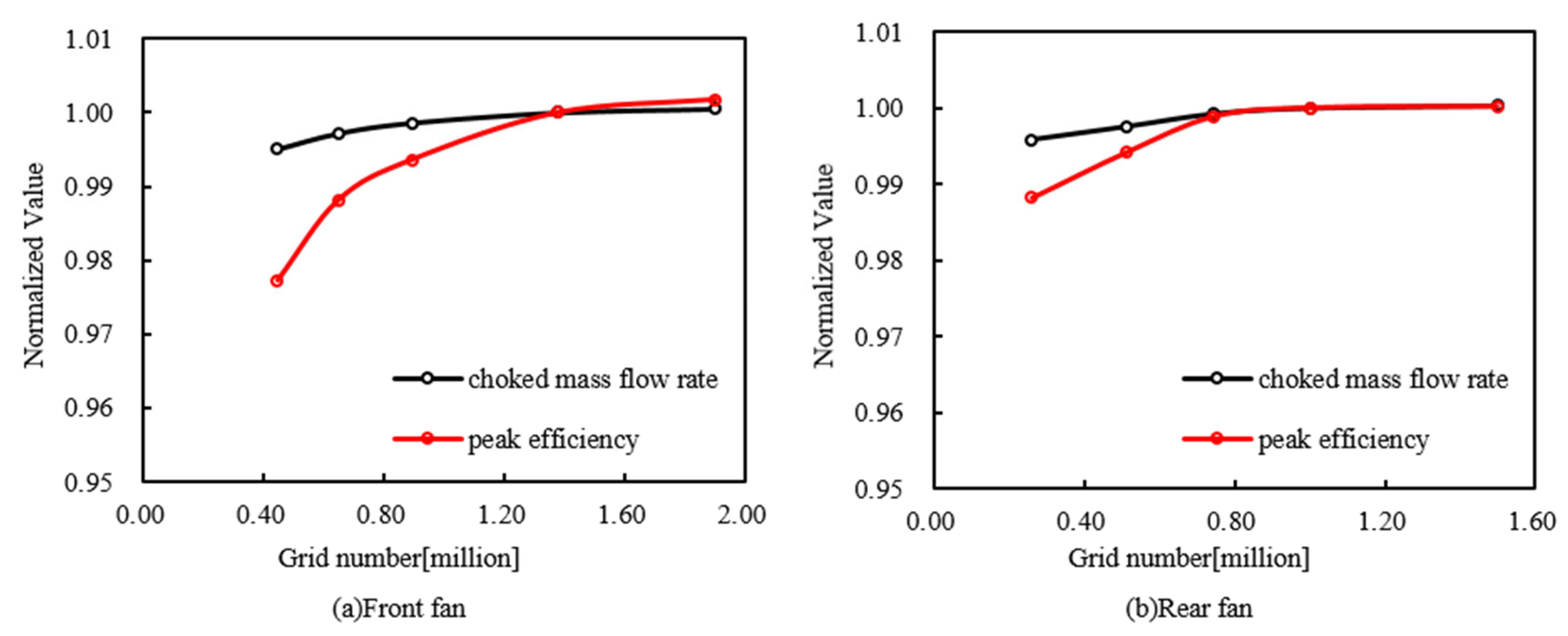
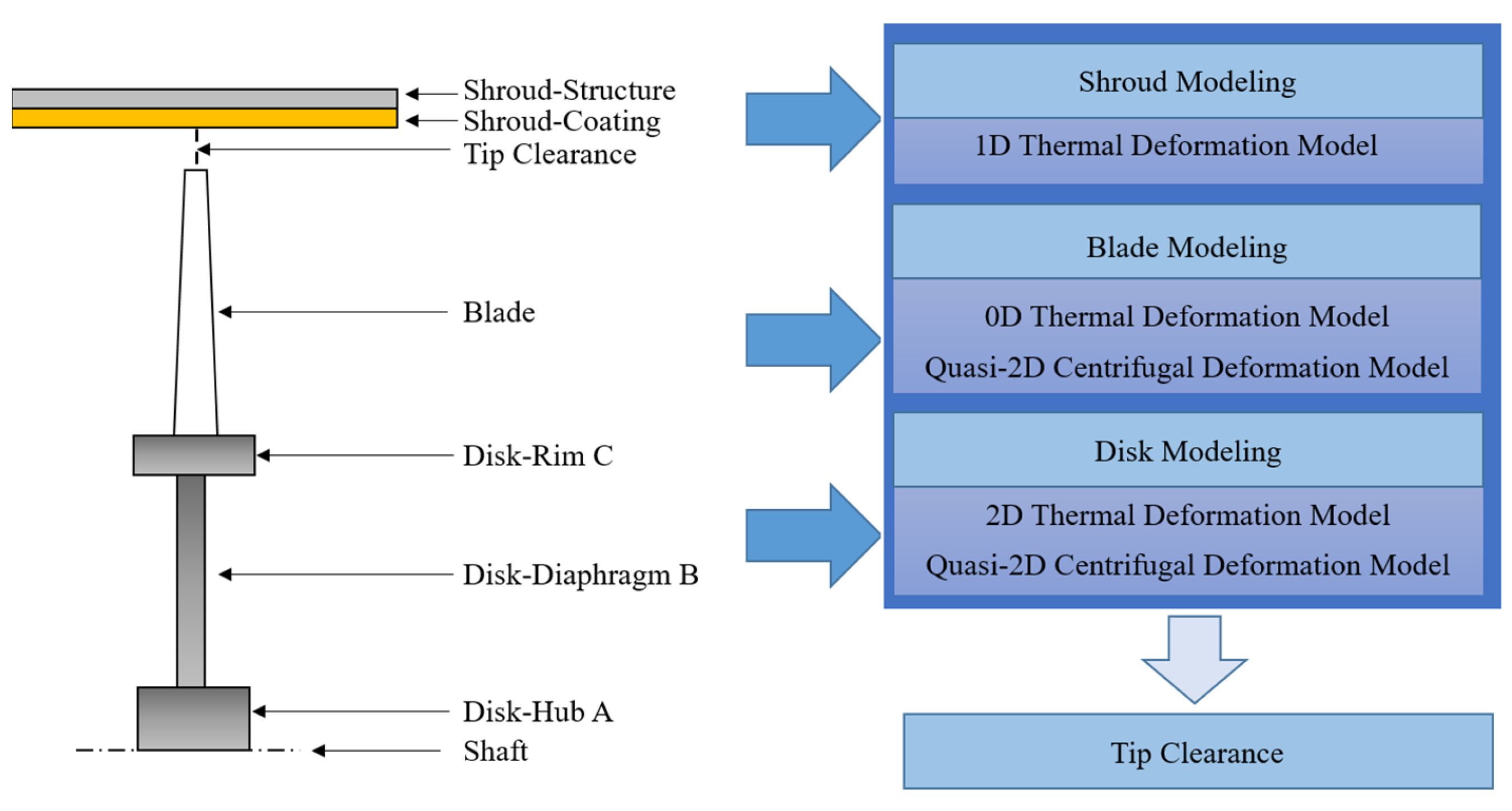


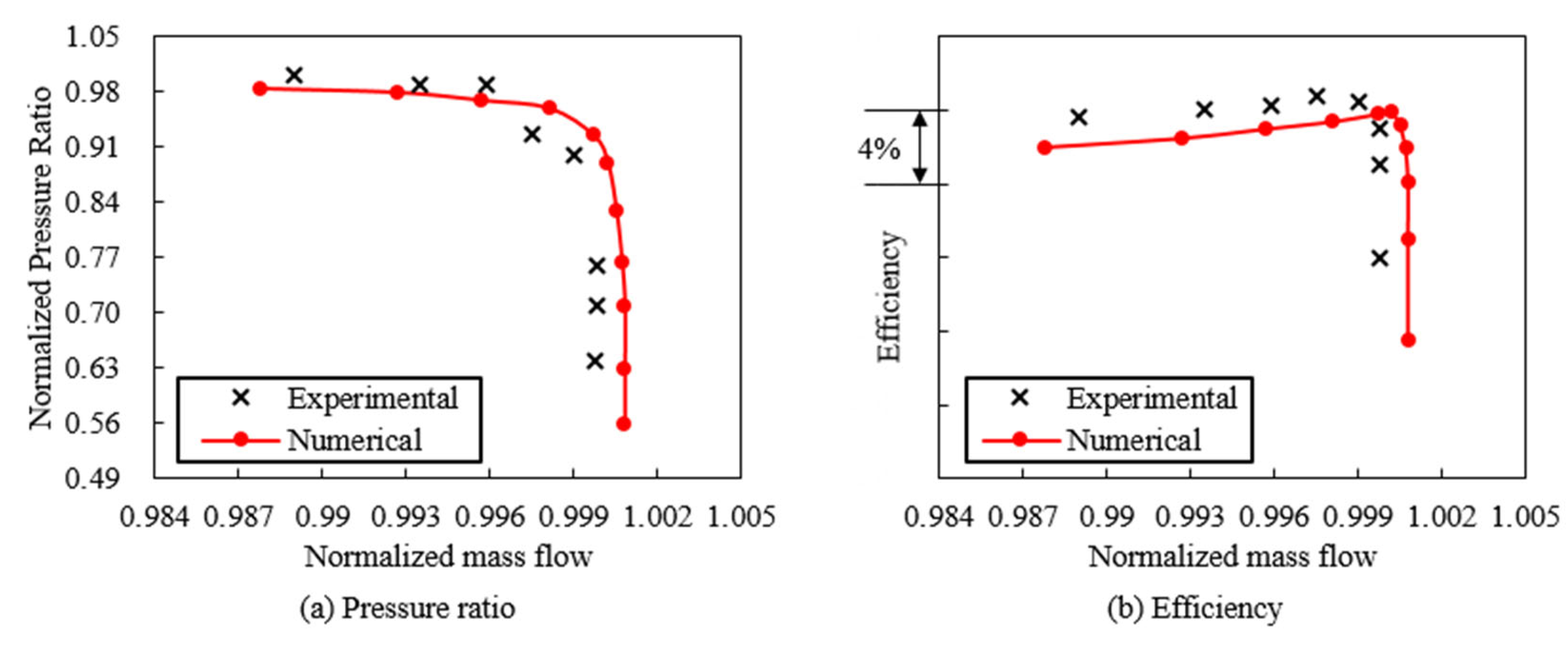
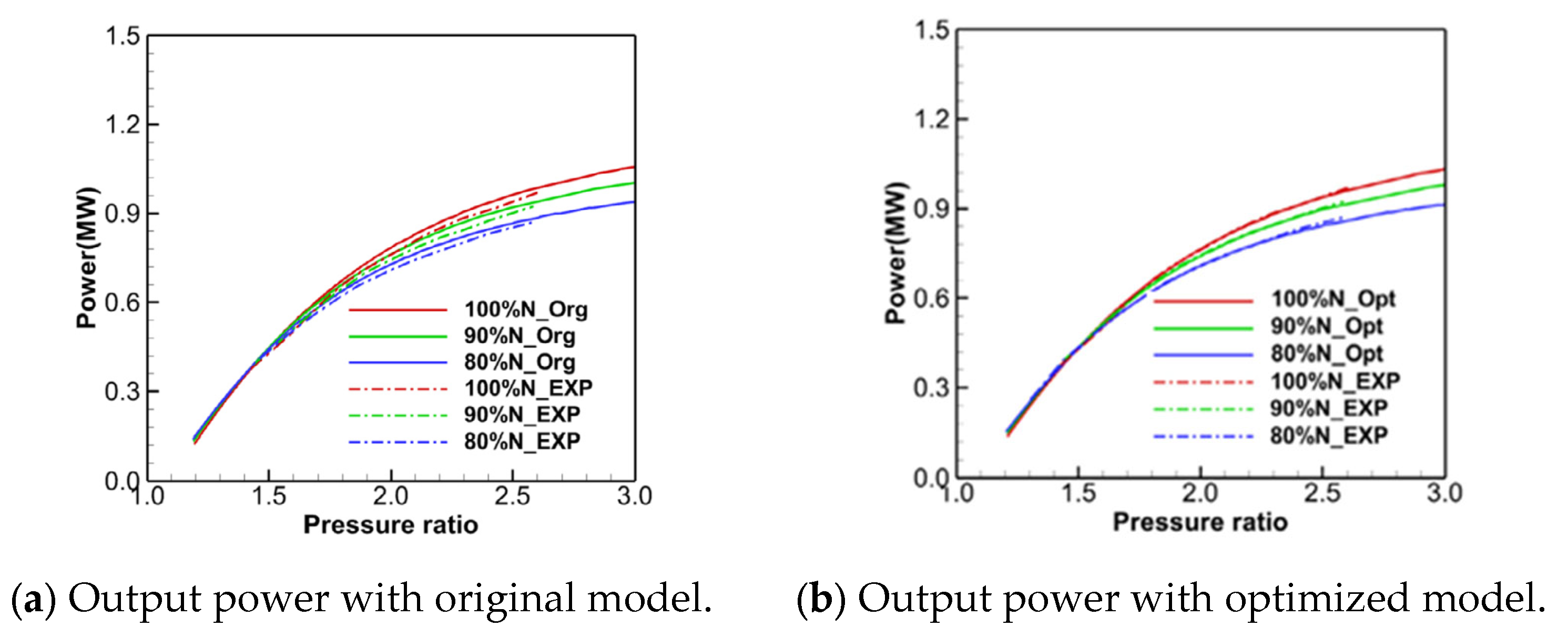
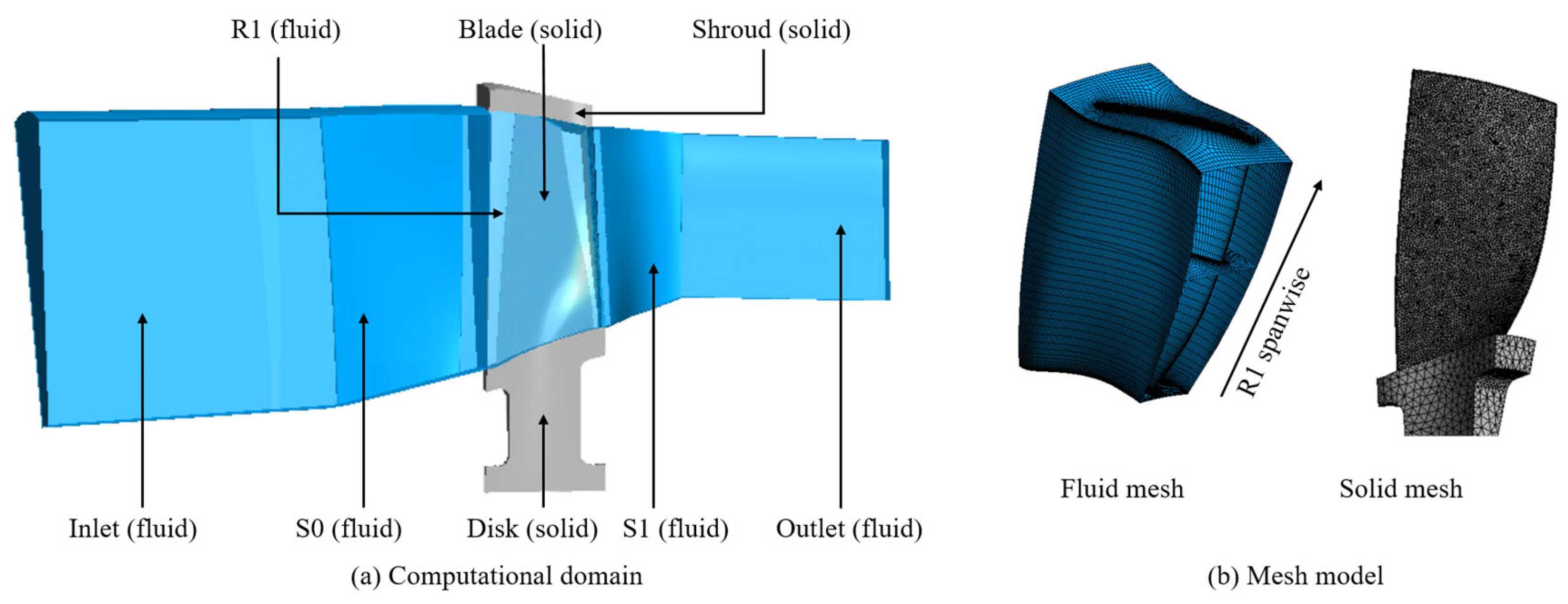
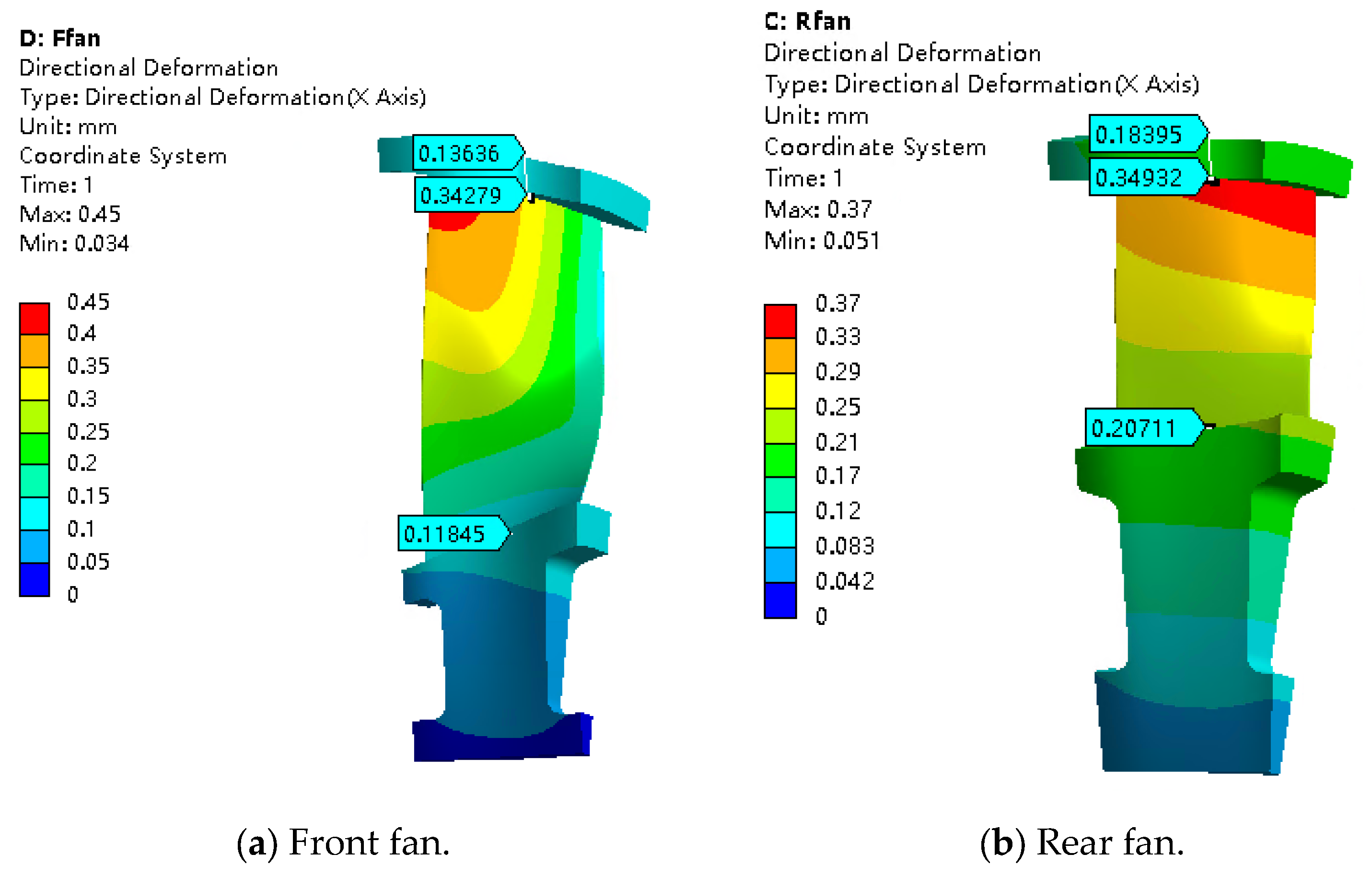

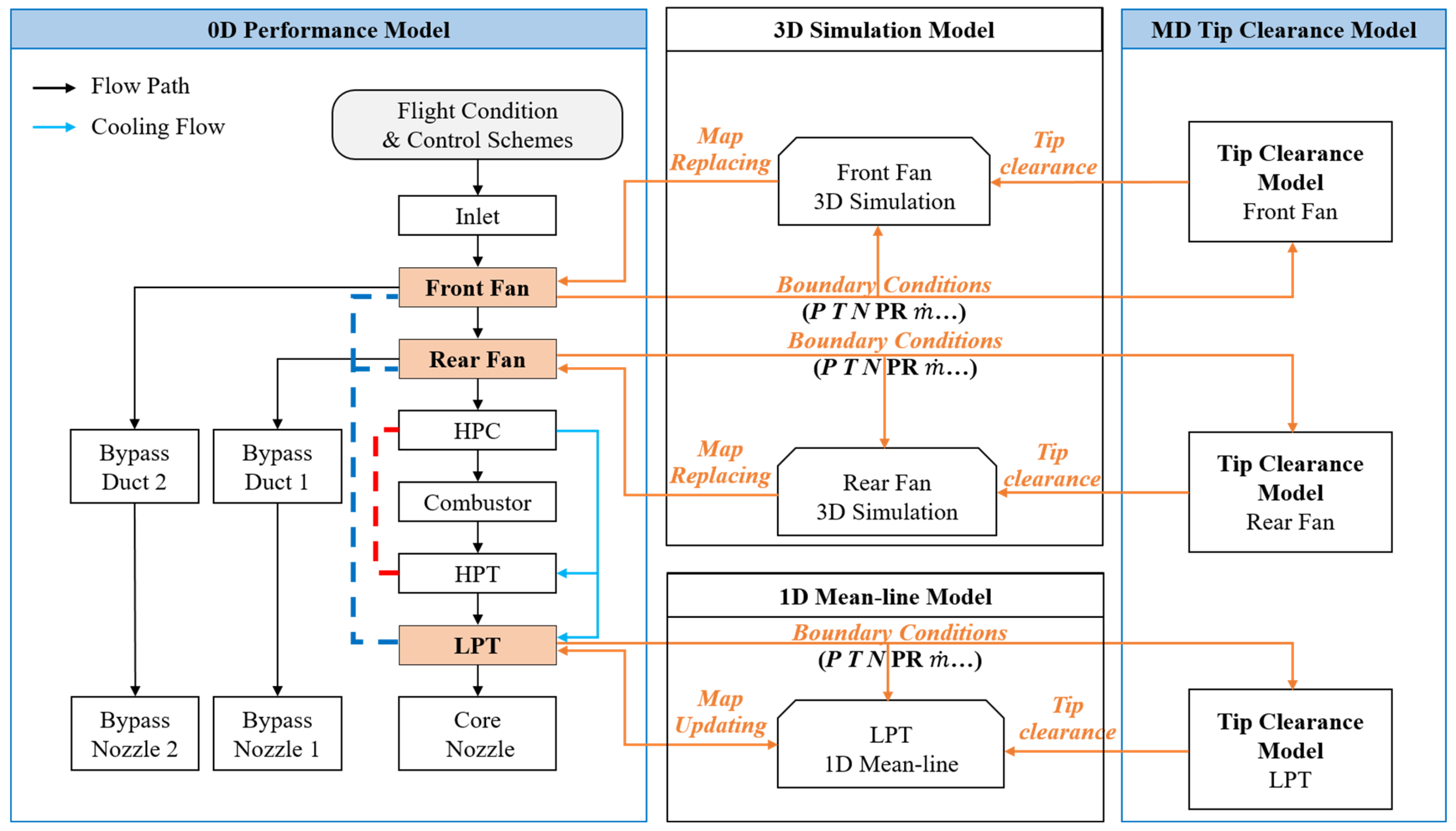
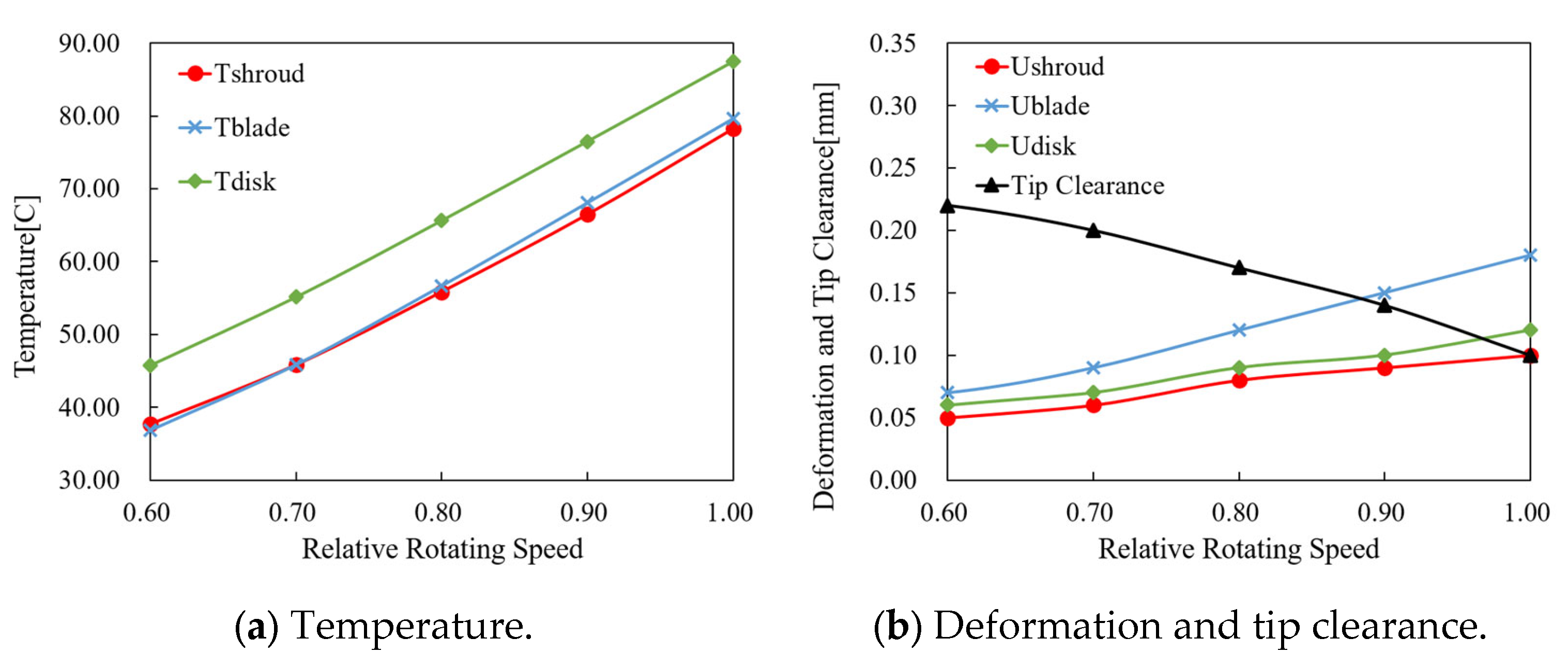

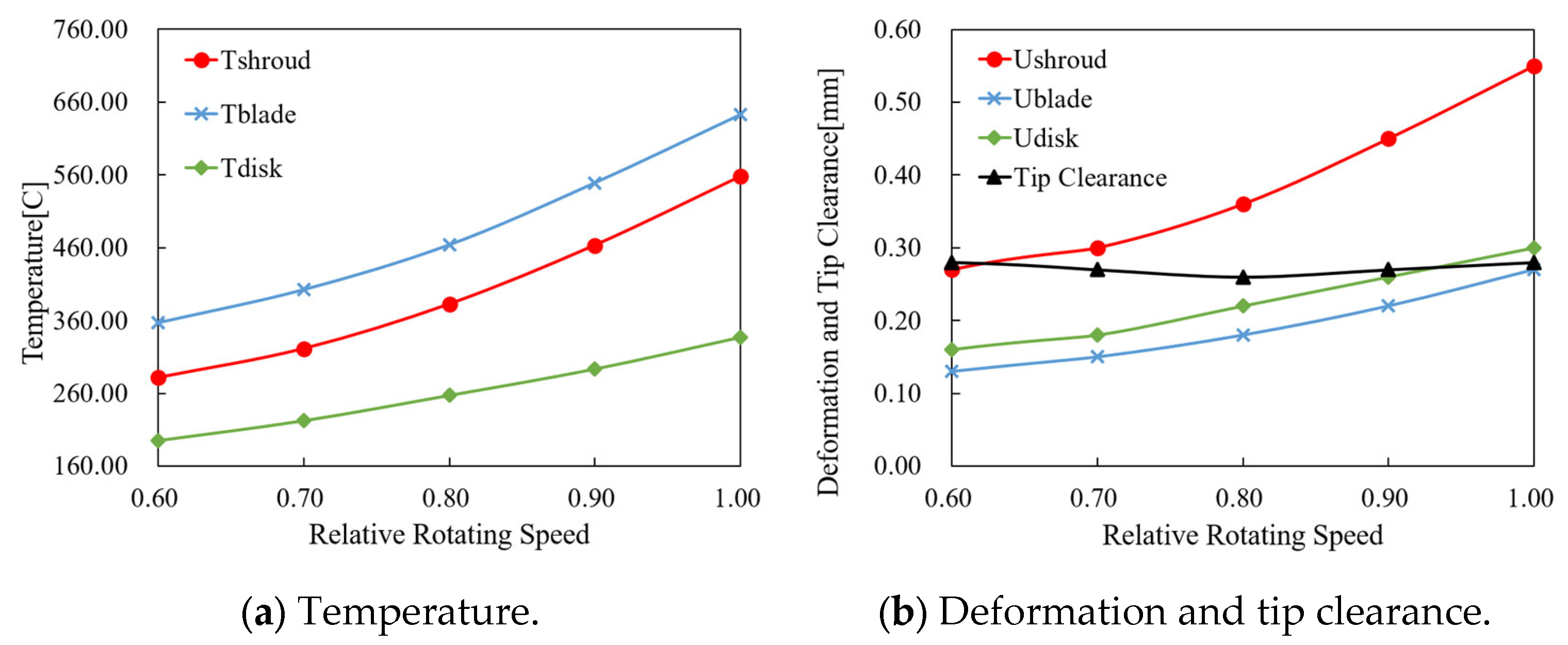
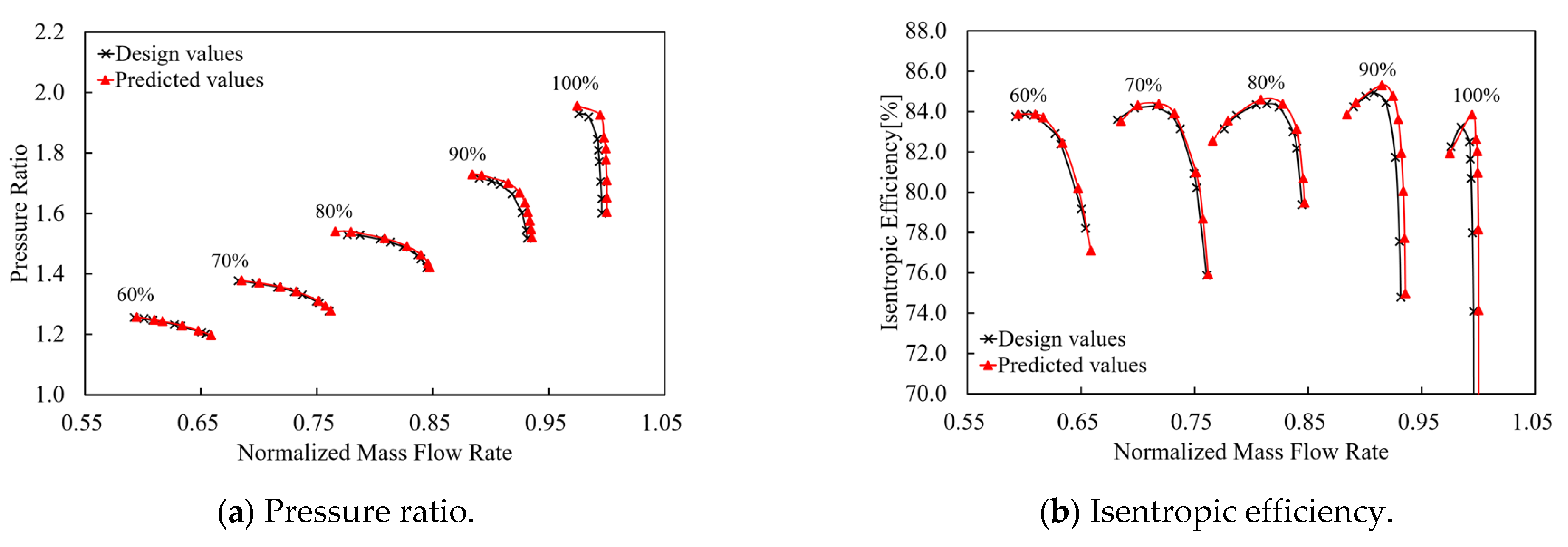
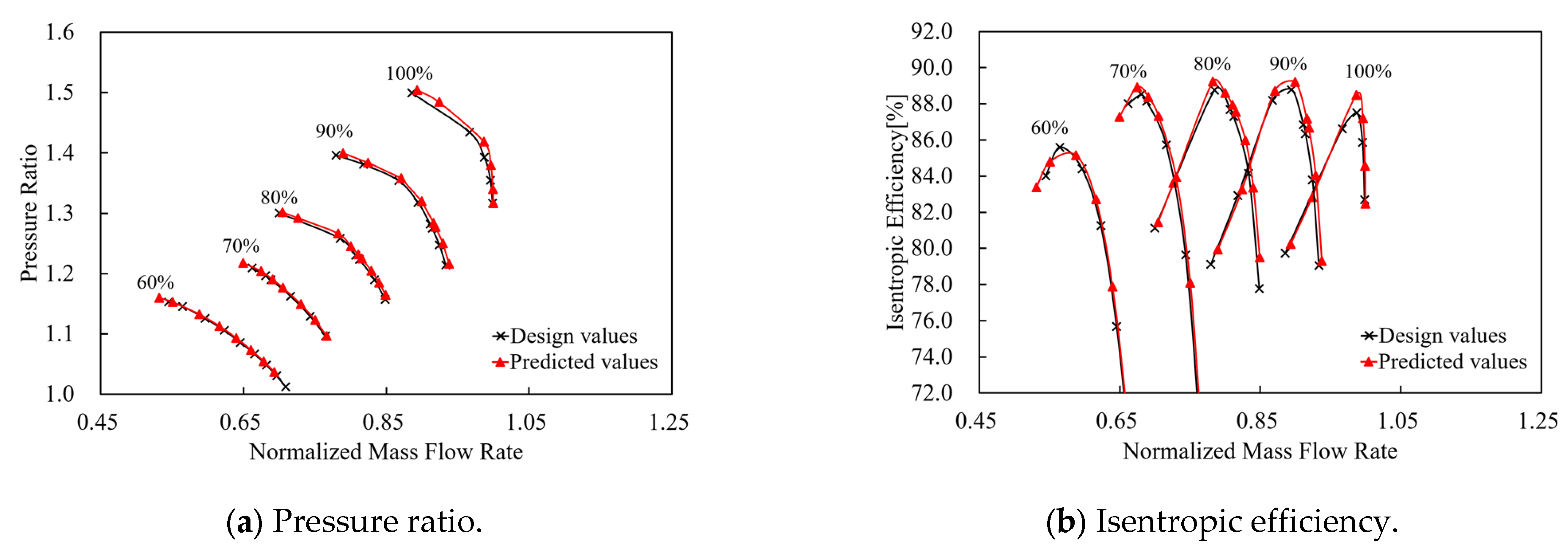

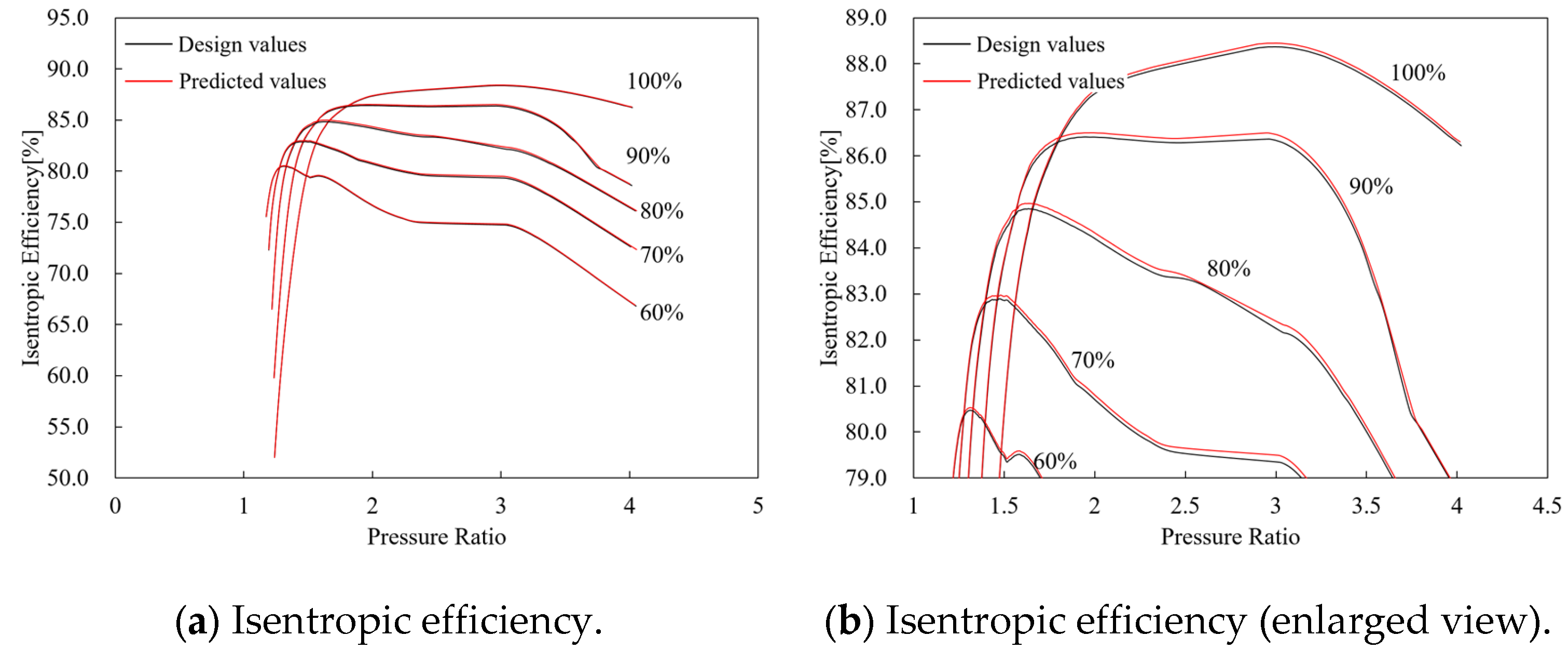


| Parameter | Value | Unit |
|---|---|---|
| Front fan pressure ratio | 1.8 | - |
| Rear fan pressure ratio | 1.42 | - |
| HPC pressure ratio | 7.0 | - |
| Turbine inlet temperature (T4) | 1700 | K |
| Front fan bypass ratio | 0.15 | - |
| Rear fan bypass ratio | 1.0 | - |
| Specific thrust | 543 | N·s/kg |
| Specific fuel consumption (SFC) | 70.68 | kg/(kN·h) |
| Parameter | Value | Unit |
|---|---|---|
| Number of S0 (front fan IGV) blades | 15 | - |
| Number of R1 (front fan rotor) blades | 28 | - |
| Number of S1 (front fan stator) blades | 46 | - |
| Assembled tip clearance of the front fan | 0.3 | mm |
| Number of rear fan rotor blades | 29 | - |
| Number of rear fan stator blades | 49 | - |
| Assembled tip clearance of the rear fan | 0.3 | mm |
| Number of LPT stator blades | 36 | |
| Number of LPT rotor blades | 53 | |
| Assembled tip clearance of the LPT | 0.3 | mm |
| Component Class | Class Number | Iteration Variable | Error Variable |
|---|---|---|---|
| Inlet | 1 | Mass flow | - |
| Compressor | 3 | R-value | Mass flow |
| Splitter | 2 | Split ratio | - |
| Burner | 1 | Fuel air ratio | - |
| Turbine | 2 | Expansion ratio | Mass flow |
| Nozzle | 3 | - | Mass flow |
| Shaft | 2 | Spool speed | Power |
| Summary | 14 | 11 | 10 |
| Shroud Deformation | Blade Deformation | Disk Deformation | Tip Clearance | |
|---|---|---|---|---|
| MDM | 0.10 mm | 0.18 mm | 0.12 mm | 0.10 mm |
| FSTM | 0.14 mm | 0.22 mm | 0.12 mm | 0.10 mm |
| Difference | −0.04 mm | −0.04 mm | 0 mm | 0 mm |
| Shroud Deformation | Blade Deformation | Disk Deformation | Tip Clearance | |
|---|---|---|---|---|
| MDM | 0.16 mm | 0.15 mm | 0.22 mm | 0.09 mm |
| FSTM | 0.18 mm | 0.14 mm | 0.21 mm | 0.13 mm |
| Difference | −0.02 mm | +0.01 mm | +0.01 mm | −0.04 mm |
| Shroud Deformation | Blade Deformation | Disk Deformation | Tip Clearance | Time | Cores | |
|---|---|---|---|---|---|---|
| 1 DM | 1.18 mm | 0.45 mm | 0.17 mm | 0.76 mm | 20 min | 4 |
| MDM | 1.00 mm | 0.35 mm | 0.36 mm | 0.49 mm | 120 min | 4 |
| FSTM | 0.97 mm | 0.30 mm | 0.30 mm | 0.57 mm | 18,000 min | 40 |
| Low-Pressure Spool Relative Speed | 100% | 90% | 80% | 70% | 60% |
|---|---|---|---|---|---|
| Front fan inlet flow angle (deg) | 0 | 0 | 0 | 0 | 0 |
| Rear fan inlet flow angle (deg) | 0 | −5 | −10 | −15 | −20 |
| Throat area of the 1st bypass nozzle (%) | 0 | 5 | 10 | 15 | 20 |
| Throat area of the 2nd bypass nozzle (%) | 0 | 15 | 30 | 45 | 60 |
| Low-Pressure Spool Relative Speed | 100% | 90% | 80% | 70% | 60% |
|---|---|---|---|---|---|
| Net thrust difference | 1.0% | 1.3% | 0.8% | 0.6% | 0.5% |
| SFC difference | −0.3% | −0.2% | −0.2% | −0.3% | −0.2% |
| T4 difference | −0.2 K | 3.0 K | 1.4 K | 0.4 K | 0.4 K |
Disclaimer/Publisher’s Note: The statements, opinions and data contained in all publications are solely those of the individual author(s) and contributor(s) and not of MDPI and/or the editor(s). MDPI and/or the editor(s) disclaim responsibility for any injury to people or property resulting from any ideas, methods, instructions or products referred to in the content. |
© 2023 by the authors. Licensee MDPI, Basel, Switzerland. This article is an open access article distributed under the terms and conditions of the Creative Commons Attribution (CC BY) license (https://creativecommons.org/licenses/by/4.0/).
Share and Cite
Wei, J.; Zou, W.; Song, Z.; Wang, B.; Li, J.; Zheng, X. A New Integrated Model for Simulating Adaptive Cycle Engine Performance Considering Variations in Tip Clearance. Processes 2023, 11, 2597. https://doi.org/10.3390/pr11092597
Wei J, Zou W, Song Z, Wang B, Li J, Zheng X. A New Integrated Model for Simulating Adaptive Cycle Engine Performance Considering Variations in Tip Clearance. Processes. 2023; 11(9):2597. https://doi.org/10.3390/pr11092597
Chicago/Turabian StyleWei, Jie, Wangzhi Zou, Zhaoyun Song, Baotong Wang, Jiaan Li, and Xinqian Zheng. 2023. "A New Integrated Model for Simulating Adaptive Cycle Engine Performance Considering Variations in Tip Clearance" Processes 11, no. 9: 2597. https://doi.org/10.3390/pr11092597
APA StyleWei, J., Zou, W., Song, Z., Wang, B., Li, J., & Zheng, X. (2023). A New Integrated Model for Simulating Adaptive Cycle Engine Performance Considering Variations in Tip Clearance. Processes, 11(9), 2597. https://doi.org/10.3390/pr11092597







